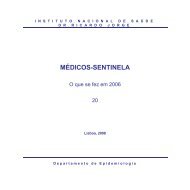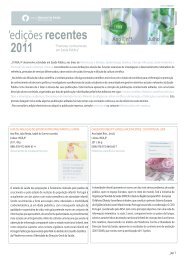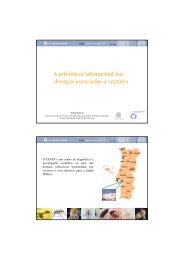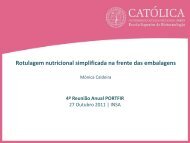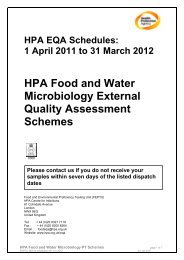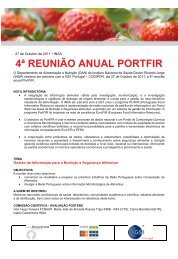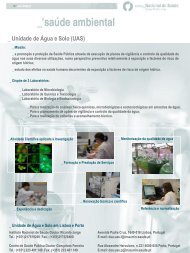European Society of Mycobacteriology - Instituto Nacional de Saúde ...
European Society of Mycobacteriology - Instituto Nacional de Saúde ...
European Society of Mycobacteriology - Instituto Nacional de Saúde ...
You also want an ePaper? Increase the reach of your titles
YUMPU automatically turns print PDFs into web optimized ePapers that Google loves.
OP-12<br />
THE CHARACTERIZATION OF MYCOBACTERIA FROM AN<br />
OUTBREAK SUGGESTS A REVISION OF THE TAXONOMIC STATUS OF<br />
MEMBERS OF THE Mycobacterium chelonae-abscessus GROUP<br />
Sylvia Cardoso Leão 1 , Enrico Tortoli 2 , Cristina Viana-Niero 1 , Suely Yoko Mizuka Ueki 3 , Karla Valeria Batista Lima 4 , Maria<br />
Luiza Lopes 4 , Jesus Yubero 5 María Carmen Menen<strong>de</strong>z 5 , Maria Jesus Garcia 5<br />
1 - Universida<strong>de</strong> Fe<strong>de</strong>ral <strong>de</strong> São Paulo, São Paulo, Brazil<br />
2 - Centro Regionale di Riferimento per la Diagnostica <strong>de</strong>i Micobatteri, Ospedale di Careggi, Firenze, Italy<br />
3 - <strong>Instituto</strong> Adolfo Lutz, São Paulo, Brazil<br />
4 - <strong>Instituto</strong> Evandro Chagas, Belém, Brazil<br />
5 - Universidad Autonoma <strong>de</strong> Madrid, Madrid, Spain<br />
An outbreak <strong>of</strong> infections by rapidly growing mycobacteria (RGM) related to invasive procedures has been ongoing in<br />
Brazil since 2004. Isolates from patients submitted to laparoscopic or plastic surgery and to mesotherapy, a cosmetic<br />
procedure, were previously i<strong>de</strong>ntified by molecular methods as Mycobacterium massiliense and M. bolletii, respectively. The<br />
similarity <strong>of</strong> rpoB and hsp65 sequences from the clinical isolates and the corresponding sequences from both M. massiliense<br />
and M. bolletii type strains were above the accepted limit for interspecies variability, leading to conflicting results.<br />
Therefore, an extensive characterization was carried out with six Brazilian clinical isolates from this outbreak study and<br />
type strains from the members <strong>of</strong> the M. abscessus-M. chelonae group – M. abscessus, M. chelonae, M. immunogenum, M.<br />
massiliense and M. bolletii. Phenotypic i<strong>de</strong>ntification was performed by biochemical tests, high performance liquid chromatography<br />
(HPLC) and drug susceptibility testing. Molecular i<strong>de</strong>ntification inclu<strong>de</strong>d PCR-restriction enzyme pattern<br />
analysis (PRA) <strong>of</strong> the hsp65 gene, as well as rpoB and hsp65 gene sequencing and analysis <strong>of</strong> the corresponding phylogenetic<br />
trees. DNA-DNA hybridization (DDH) and restriction fragment length polymorphism (RFLP) <strong>of</strong> the 16S rRNA<br />
gene were used as the gold standards for RGM speciation. The clinical isolates and the M. abscessus, M. massiliense and<br />
M. bolletii type strains could not be separated by phenotypic tests and were grouped in the phylogenetic trees obtained.<br />
Also, DDH results confirmed >70% relatedness, and indistinguishable RFLP 16S rRNA patterns were obtained. On the<br />
contrary, separation from M. chelonae and M. immunogenum was supported by results from PRA-hsp65, rpoB and hsp65<br />
phylogenetic trees, DDH and RFLP-16S. Taken together, these results led to the proposition that M. abscesus, M. massiliense<br />
and M. bolletii represent a single species, that <strong>of</strong> M. abscessus. Two subspecies are also proposed, M. abscessus subsp.<br />
abscessus and M. abscessus subsp. massiliense which can be distinguished by two different PRA-hsp65 patterns, differing in<br />
a single Hae III band, and by differences in rpoB (3.4%) and hsp65 (1.3%) sequences.<br />
54 ESM 2009



